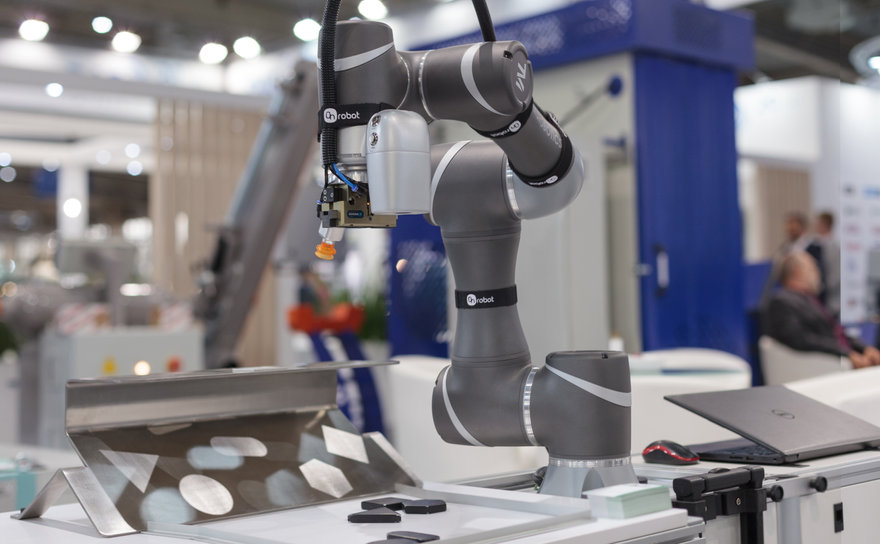Cobots vs. Industrial Robots: Which is the Right Automation Solution?
As the application of automation and robotics continues to grow, robots can be found in almost every industrial facility. However, choosing between a collaborative robot or a traditional industrial robot can be difficult. This blog will explore the key differences between these two powerful automation solutions to help you make an informed decision.

What is an Industrial Robot?
Traditional industrial robots, which have been used throughout the manufacturing industry for decades, are powerful, large-scale machines designed for high-volume, repetitive or dangerous tasks.
While they offer high speeds and impressive payload capacities, industrial robots require safety caging or other barriers to keep human workers safe. Traditional robots are commonly used for welding, material disassembly, heavy-duty material handling and automobile assembly.
What is a Collaborative Robot (Cobot)?
Cobots, a newer type of robot, are designed to work safely alongside human employees. They are equipped with safety sensors that detect humans and other obstacles to avoid collisions or reduce the impact if one occurs. While a risk assessment is still required, cobots can likely be used without extensive safety guarding.
Compared to traditional robots, cobots are smaller, lighter in weight, easier to program and safer for use around humans.
Key Differences: Industrial Robot vs. Cobot at a Glance
| Feature | Industrial Robot | Cobot |
| Human Interaction | Operates in an isolated, caged area for safety. | Designed to collaborate safely with humans. |
| Cost | Higher initial investment. | More cost effective and less expensive to integrate. |
| Safety | Requires risk assessment. Relies on external caging and barriers for safety. | Requires risk assessment. Features built-in safety sensors to avoid collisions. |
| Programming & Set Up | Requires specialized training and can take weeks to set up. | User-friendly, plug-and-play design allows fast set up and simplifies programming. |
| Size & Footprint | Large and powerful, requiring significant dedicated space for robot and caging. | Smaller, lighter and more flexible for easier integration into existing workflows. No caging required. |
| Ideal Tasks | High-speed, heavy-payload and hazardous tasks. | Precision, assistance-based and lighter payload tasks. |
Advantages and Disadvantages of Cobots
Cobots offer the following advantages:
- Increased safety and collaboration: Designed for safe use near humans for collaborative operation.
- Ease of use and fast set up: Minimal training is required and plug-and-play functionality enables simple set up and operation.
- Cost effective: Lower upfront costs and no major infrastructure changes minimize investment costs.
- Flexibility: Cobots are easy to reprogram for different tasks and lightweight enough to move around the facility.
Disadvantages of cobots include:
- Slower speeds: Cobots generally operate at slower speeds than industrial robots to ensure safety around humans.
- Lower payload: Cobots are not suitable for very heavy-lifting tasks where industrial robots excel.
- Risk assessment required: While inherently safer, a thorough risk assessment is still required to ensure safe operation in the application.
When to Choose an Industrial Robot
Despite the lower price tag, safer operation and ease of use of collaborative robots, there are applications where industrial robots are a better fit.
Industrial robots offer:
- Maximum speed and power: Faster speeds and high-payload capacities make industrial robots a better choice when high-volumes and heavy lifting are required.
- Safety in hazardous applications: Industrial robots can safely work in dangerous environments with extreme temperatures, fumes and toxic dusts or other hazards to mitigate risks to human workers.
- Management of simple, repetitive tasks: Industrial robots can perform tedious, repetitive jobs without human collaboration, reducing repetitive motion injuries in the workplace and freeing workers to complete more complex tasks.
Overcome Manufacturing Challenges with the Right Solution
Both cobots and traditional industrial robots will improve productivity, efficiency and safety, but the best solution is the one that meets the needs of your specific application. Unsure which type of robot is right for your operation? Our automation experts are here to help. Contact us today for an evaluation. Want to see the potential ROI? Use our free Robotics Savings Calculator to estimate how much you can save with an automated solution.
